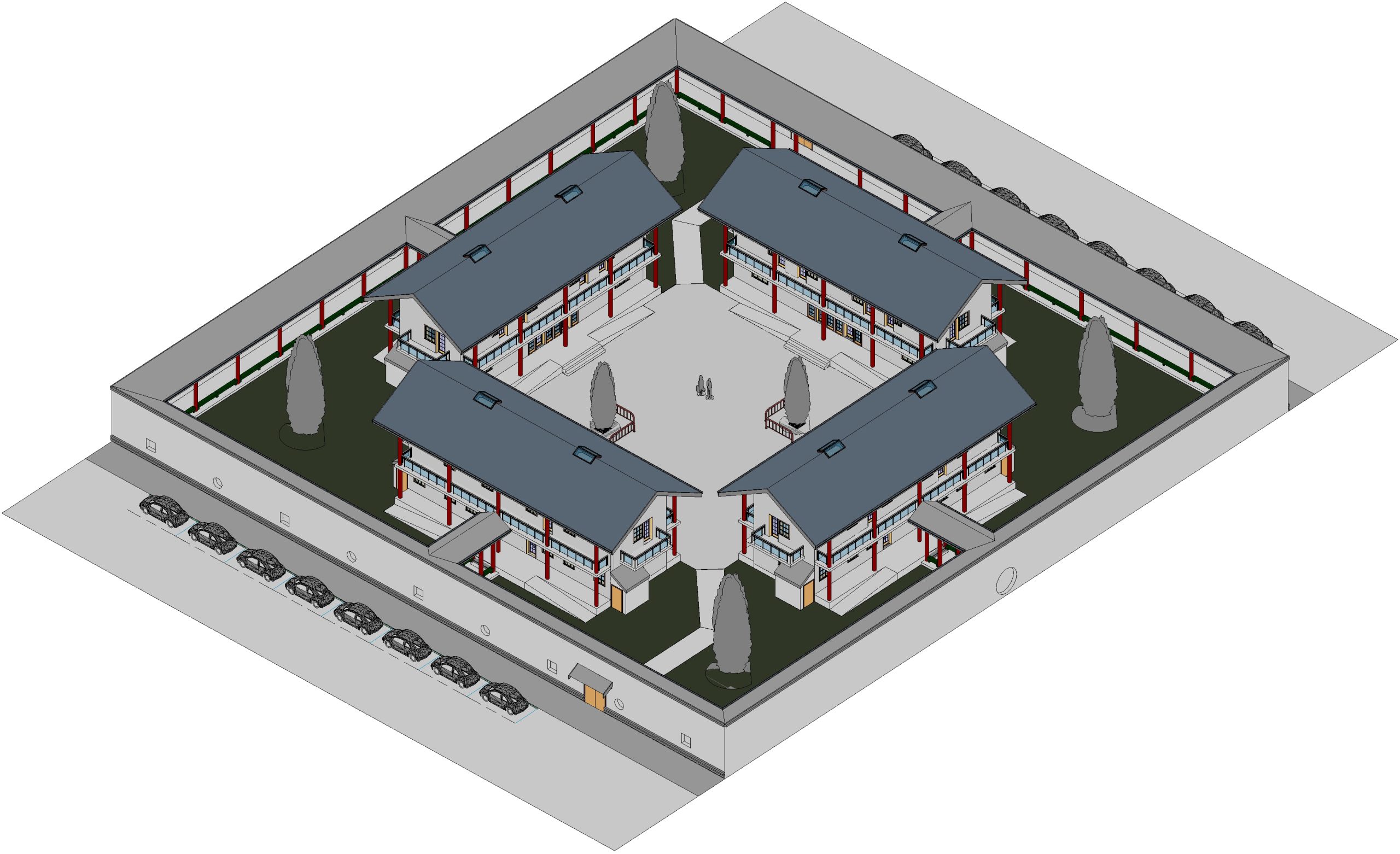35
Donia Zhang, York University, Canada
The United Cities and Local Governments have now endorsed a four-pillar sustainable development framework that includes environmental responsibility, economic viability, social equity, and cultural vitality. Whilst in his book The Nature of Design, David Orr (2002) maintained that sustainability is a modern term for “longevity” (p. 11), whose essence is “health” (p. 29). This blog is set within this context and looks at Chinese urban planning and courtyard housing development from a cultural perspective. The study defines cultural sustainability as the “adaptation and transmission of the beneficial parts in a nation’s material (tangible) and immaterial/spiritual (intangible) culture that are conducive to the development of their present and future generations” (Zhang, 2013, p. 31). The paper reflects the author’s 20 years of research on the topic and argues that sustainable urbanization in China necessitates four ingredients: planning with Chinese history and philosophy, designing for cultural health and happiness, taking the human-centered approach, and building for housing longevity.
Planning with Chinese History and Philosophy
China has a rich history and philosophy on city planning that can be traced back 5,000 years (Fu et al, 2002). Unlike naturally evolved European capital cities such as London, Chinese capital cities such as Beijing were initially planned entities following the principles set in the Record of Trades in Rituals of Zhou. These principles emphasize harmony on four levels: harmony with heaven, harmony with earth, harmony with humans, and harmony with self (Zhang, 2013). These doctrines have generated regular grid urban patterns, with courtyard housing as the basic units embedded in most imperial Chinese cities (Fu et al, 2002; Knapp, 2005; Ma, 1999). This grid pattern and the courtyard form must be preserved as they satisfy our current quest for sustainable development.
Noticeably, however, China’s historic urban configuration had undergone wholesale destruction over the last 60 years (1950-2010), when the courtyard housing structure had been largely replaced with the imported Soviet-style parallel walk-up apartments in the 1950s-1970s, and the American-style tower blocks from the late 1970s onwards.
Arguably, the courtyard form should be valued as a primary approach to new housing development in China, such as the Juer Hutong (“Chrysanthemum Lane,” b. 1990-1994) and Nanchizi (“South Pond,” b. 2003) new courtyard housing prototypes in Beijing, partly because numerous research findings all suggest that the courtyard layout, or parameter block, in fact saves land more than an individual building sitting in the middle of a plot/site as exemplified in most Western planning practices (Martin and March, 1972; Shang and Yang, 1982; Wu, 1999; Zhang, 2006, 2011); and partly because courtyard housing facilitates residents’ traditional cultural expressions, and is conducive to their social interaction and cultural activities (Zhang, 2013, 2015).
Designing for Cultural Health and Happiness
Scholars such as Darlow (1996) and Wheelwright (2000) have observed that sustainable development is largely a cultural task that seeks a change in attitudes and lifestyles. Housing is where people’s daily lives take place. The author’s research findings indicate that courtyard housing is congruent with traditional Chinese philosophy to promote health and happiness at home, with the four recurring themes: health as balancing Yin Yang, health as gathering qi, happiness as attaining oneness, and happiness as knowing the Dao (Zhang, 2015).
The courtyard form is associated with all the four themes, and incorporating the courtyard feature when planning and designing Chinese cities could contribute to cultural sustainability, and foster residents’ physical and psychological health and happiness (Zhang, 2013, 2015).
Conversely, if Chinese new housing developments blindly copy, rather than wisely adapt, foreign traditions, such as the European- and American-Canadian-style villa estates built in the suburbs of Beijing and Shanghai (King, 2004; Zhang, forthcoming 2015), the outcomes are often spatial alienation and confusion, leading to a potential breakdown in China’s architectural heritage, albeit these houses may meet the demands of some of the foreign expatriates residing in China.
Taking the Human-Centered Approach
Sustainable urbanization requires taking the “human-centered” approach because cities and housing are ultimately built for the people who inhabit in them; user satisfaction is the final judgment of their quality. A courtyard garden house compound hosting 4-8 nuclear families (Zhang, 2013, 2015) designed with classical Chinese garden elements (Keswick, 2003; Wang, 2005) that encourage walking and human activities without the threat of cars, would be healthy and culturally sustainable.
To further promote health and happiness, Chinese city planning and housing design should comply with Feng Shui because this theory has scientific basis. Feng Shui closely correlates with “neuroarchitecture,” which is an emerging field of environment-behavior (E-B) study that combines neuroscience with architecture. This interdisciplinary inquiry takes the human-centered approach that connects architecture with physiology and psychology, rather than physics, as did traditionally in Western scholarship, and therefore it provides a more sensible method for urban planning and housing design than the old, object-oriented approach.
Building for Housing Longevity
Sustainable urbanization is about creating cities and housing that are healthy for the inhabitants and long-lasting as structures. However, the construction quality in China has widely been recognized as a critical issue, and some of the renewed and new courtyard housing projects constructed in Beijing since the 2000s deteriorated only after 2-3 years of erection. Reasons for low-quality constructions can be attributed to short-term planning of a 20-30 year lifespan of buildings set by China’s Ministry of Housing, poor designs, inferior materials, weak construction management, and a zealous completion timeline, as well as developers’ drive for profit, workers’ skill inadequacies, and so on (Zhang, 2013). Construction quality assurance is definitely needed but was often missing in China, and good maintenance and management of the buildings will also ensure their longevity.
Since a house is a fairly permanent structure, once built, it cannot be changed easily to accommodate newer demands or higher standards. Therefore, housing designs should not be compromised for less than stable requirements in density, plot ratio, or floor-area ratio because while a population may fluctuate with time, a housing form may be less flexible. It is actually more economical and environmental to build for the long-term than to demolish and rebuild at a later time. Sustainability is thus viewed as more of a cultural task in changing our attitudes and approaches to rehabilitating old cities and planning new ones to enhance social and human development.

References
Darlow, A. (1996). Cultural policy and urban sustainability: making a missing link? Planning Practice and Research, 11(3), 291-301.
Fu, X., Guo, D., Liu, X., Pan, G., Qiao, Y., and Sun, D. (2002). Chinese architecture (Translated and Edited by N.S. Steinhardt). New Haven: Yale University Press.
Keswick, M. (2003). Chinese garden: history, art and architecture. Cambridge, MA: Harvard University Press.
King, A.D. (2004). Spaces of global cultures: architecture, urbanism, identity. London: Spon.
Knapp, R.G. (2005). Chinese houses: the architectural heritage of a nation. North Clarendon, VT: Tuttle Publishing.
Ma, B. (1999). The architecture of the quadrangle in Beijing (Chinese edition). China: Tianjin University Press.
Martin, J. L. and March, L. (1972). Urban space and structures. Cambridge, UK: Cambridge University Press.
Orr, D.W. (2002). The nature of design: ecology, culture, and human intention. New York: Oxford University Press.
Shang, K. and Yang, L. Y. (1982). Traditional courtyard houses and low-rise high density. Architectural Journal, 5, pp. 51-60.
Wheelwright, P. (2000). The problem of sustainability: a response (Response to Molecules, Money, and Design by Mark Jarzombek). Thresholds 20, MIT Journal, Fall 2000. Retrieved August 4, 2004 from: http://www.pmwarchitects.com/ac_tech.htm
Wang, J.C. (2005). House and garden: sanctuary for the body and the mind. In R.G. Knapp and K.-Y. Lo (Eds.), House home family: living and being Chinese (pp. 73-97). Honolulu: University of Hawai’i Press.
Wu, L. (1999). Rehabilitating the old city of Beijing: a project in the Ju’er Hutong neighbourhood. Vancouver, BC: University of British Columbia Press.
Zhang, D. (2006). New courtyard houses of Beijing: direction of future housing development. Urban Design International, 11(3), pp. 133-150.
Zhang, D. (2011). Courtyard houses of Beijing: past, present, and future. Saarbrücken: VDM Verlag.
Zhang, D. (2013). Courtyard housing and cultural sustainability: theory, practice, and product. Farnham: Ashgate.
Zhang, D. (2015). Courtyard housing for health and happiness: architectural multiculturalism in North America. Farnham: Ashgate.
Zhang, D. (forthcoming, 2015). Courtyard housing in China: Chinese quest for harmony. Journal of City, Culture and Architecture, 1(1).
Author Biography
Dr Donia Zhang is an associate at the City Institute, York University. She is a graduate of Oxford Brookes University (BArch, MA, PhD) in the UK and Brock University (MEd) in Canada. Her area of expertise is in courtyard housing development in China and North America, China’s heritage preservation policies and practices, cultural sustainability, and architectural multiculturalism. Donia has authored four scholarly books: Courtyard Houses of Beijing: Past, Present, and Future (2009/2010/2011), Schoolyard Gardening as Multinaturalism: Theory, Practice, and Product (2009), Courtyard Housing and Cultural Sustainability: Theory, Practice, and Product (Ashgate, 2013), and Courtyard Housing for Health and Happiness: Architectural Multiculturalism in North America (Ashgate, 2015). Her current research focuses on “Cultural Education for Cultural Sustainability: Chinese School Curriculum in Multicultural West.” She is developing the course: “Introduction to Chinese Culture” to promote harmony, happiness, health, and healing in higher education.
Contact email: doniazhang@gmail.com

